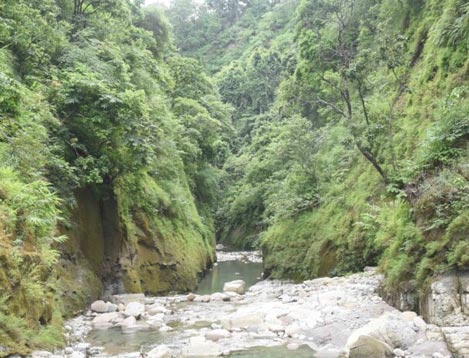Places to see around Valmiki Tiger Reserve
In the Valmiki Tiger Reserve, a seamless blend of culture and wildlife creates a dreamlike ambiance, offering an array of enchanting activities. The undulating natural terrain sets the stage for a diverse range of experiences, including thrilling jeep safaris, adventurous boat rafting, and trekking to the scenic Someshwar Peak. This reserve, teeming with a variety of plants, animals, and birds, beckons wildlife enthusiasts globally. Whether one seeks to delve into the reserve's natural wonders through safaris and nature walks or craves adventurous escapades like rafting, boating, and trekking, Valmiki Tiger Reserve caters to all.
Capturing the Reserve's splendour against a backdrop of small mountains and meandering rivers is a delight for photographers. Birdwatchers find paradise here, with over 250 bird species filling the air with melodious tweets amid the lush forests. Valmiki Tiger Reserve truly offers an immersive experience where every activity, from wildlife exploration to thrilling adventures, unfolds against the stunning canvas of nature's diversity.


Pandai River
Valmiki Tiger Reserve marks the easternmost boundary of the Himalayan Terai forests in India and is the sole tiger reserve in Bihar. Located in the Gangetic Plains bio-geographic zone, the reserve features a mix of bhabar and terai tracts. It is situated in the northwestern part of the West Champaran district. The Pandai River enters Bihar from Nepal at the sanctuary's eastern edge and converges with the Masan River. Numerous rivers and their tributaries, including Rohua, Kotrahia, Manor, Bhapsa, Koshil, Singha, Dhonghi, Ganguli, and Dhoram, traverse the area with energetic flows. Their playful cascades down hills, ridges, and gorges create enchanting scenes, gradually maturing into serene grandeur as they reach the plains.
Near the Pandai River, which flows along the India-Nepal border, lies Bikhnathori. The riverbed, almost dry, is covered with pebbles, while the distant Himalayan peaks shine majestically. The Pandai River, a small transboundary river, is believed to be named after the "Pandavas" from the Mahabharata. It originates from the Someshwar range of hills and serves as a left-bank tributary of the Budhi Gandak River, joining it at Tularamghat after the Budhi Gandak has travelled approximately 54 kilometres from its source. For a short stretch, the Pandai River forms the international boundary between Chitwan National Park in Nepal and the Valmiki Tiger Reserve in India. During the pre-monsoon months, the stony riverbed has only a few streams of water trickling down. The residents of more than a dozen villages in both Nepal and India rely heavily on this limited water supply for their daily needs and to irrigate their farms.
Parewa Dah
In the local language, "parewa" or "parba" means pigeon, and "dah" means water body, so Parewa Dah is a place where both coexist. It is one of the most picturesque spots in Valmiki Tiger Reserve, located en route to the Someshwar temple. The emerald blue, crystal-clear waters here are home to numerous fish, with a waterfall flowing continuously. The area is also known for the hundreds of doves and bee-eaters nesting in the high burrows around it. A visit to the forest isn't complete without experiencing Parewa Dah.
Someshwar Peak
Someshwar, the highest peak in Valmiki Tiger Reserve, rises to 2,884 feet. It is accessible via a 14 km trek from the base camp, passing Titanic Point, which offers a splendid view from the top. The peaks of the Someshwar hills provide breathtaking views of both India and Nepal, with stunning gorges cutting through the Terai hills. The visible layers of sedimentary rock at Parewa Deh waterfall offer a memorable experience. At the summit of Someshwar peak sits the Someshwar Temple, dedicated to Lord Shiva and steeped in mythological significance. Below the temple lie the ruins of the hermitage of sage Bhatrihari. The dense forests in the oblong section of Someshwar Block, stretching from Gobardhana to Dhumatkar-Kasauli, offer an adventurous safari experience.
Valmiki Ashram
Valmiki Nagar, a small settlement of great mythological importance, is situated near the boundaries of the Tiger Reserve. The village is named after the Hindu sage Valmiki, who is believed to have written the epic Ramayana. The Valmiki Ashram, located on the village outskirts, is historically significant as the site where the epic is said to have begun. According to legend, Lord Rama visited this Ashram and left his pregnant wife, Sita, there after rescuing her from Ravana. It is also where their sons, Luv and Kush, were born and raised. Today, the Valmiki Ashram is located within Chitwan National Park in Nepal.
Valmiki Tiger Reserve Nature Walk
One of the top activities in Valmiki Tiger Reserve is the Nature Walk, perfect for those eager to explore the area's natural beauty. These walking trails wind through dense canopies and are a delight to traverse. Each walk covers about 4-5 kilometers and is conducted in small groups of 4 to 6 people. An expert nature guide accompanies each group, providing valuable insights into the local flora and fauna.